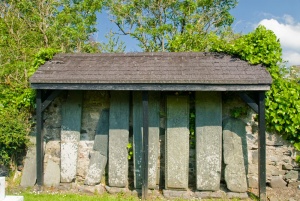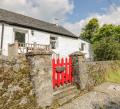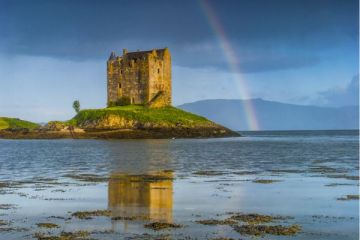
The village of Clachan is near the north western tip of Kintyre, and served for many years as the ecclesiastical centre for north Kintyre.
The church was built around 1760 to replace an earlier building. Fragments of stones on the site suggest a very early Christian church, possibly dedicated to Columbanus, a disciple of St Columba.
The age of the first church at Clachan is uncertain, but it must have been an ancient foundation, given the importance of Clachan as a church centre and the early dedication.
The importance of Clachan is emphasised by a number of very worn early medieval grave slabs in the churchyard. The best of these have been gathered together under a lean-to in one corner of the churchyard to protect them from the weather.
Several of the stones are early medieval, one is an undecorated cross, and at least 2 are medieval slabs. Several of the slabs are carved with the symbol of a sword, and at least one with the symbol of a cross.
One of the sword slabs also shows a pair of what appear to be hounds near the sword hilt. One slab shows an extremely well-carved side, decorated with a regular pattern of rectangles. Though most of the stones are very worn, the quality of the carving is striking.
Many of the grave slabs are thought to commemorate the chiefs of Clan McAllister. Against the churchyard wall is an unusual carved stone with a Latin cross beneath a ring cross, both joined to a common stem.
Though not as impressive as the grave slabs displayed at Saddell Abbey on the east coast of Kintyre, I quite enjoyed visiting the Clachan stones. Many of them are quite worn with time, but the setting is impressive and the village is quite pretty.
Balinakill House, near the church, was the home of Coll McAlester, who in 1739 led a group of settlers to Cross Creek in North Carolina.
Balinakill House was also the home of Sir William Mackinnon (1823 - 1893), a native of Campbeltown who began as an apprentice to a grocer and became in time a wealthy shipowner. Mackinnon founded the British India Steam Navigation Company and the Imperial British East Africa Company, and left money in his will to 'provide a decent education to deserving Highland lads'.
The result was the Keil school in Dumbarton, which closed in 2000. Mackinnon is buried in the churchyard at Clachan and his birthplace in Campbeltown in marked by a commemorative plaque.
On Dunskeig hill, outside the village, are a series of three hill forts, one of which is vitrified.
About Clachan Church Grave Slabs
Address: Clachan,
Argyll and Bute,
Scotland, PA29 6YP
Attraction Type: Historic Church
Location: The grave slabs are in the graveyard of Clachan church, just off the A83 in Clachan village
Location
map
OS: NR764560
Photo Credit: David Ross and Britain Express
NEARBY HISTORIC ATTRACTIONS
Heritage Rated from 1- 5 (low to exceptional) on historic interest
Kilberry Sculptured Stones - 6.1 miles (Museum) ![]()
Avinagillan Standing Stone - 8.5 miles (Prehistoric Site) ![]()
Skipness Castle - 8.9 miles (Castle) ![]()
Beacharr Standing Stone - 9 miles (Prehistoric Site) ![]()
Tarbert Castle - 10.1 miles (Castle) ![]()
Coire Fhionn Lochan - 10.6 miles (Countryside) ![]()
Lochranza Castle - 10.9 miles (Castle) ![]()
Carradale Network Heritage Centre - 11.3 miles (Museum) ![]()
Nearest Holiday Cottages to Clachan Church Grave Slabs:
Nearby accommodation is calculated 'as the crow flies' from Clachan Church Grave Slabs. 'Nearest' may involve a long drive up and down glens or, if you are near the coast, may include a ferry ride! Please check the property map to make sure the location is right for you.
Tighnabruaich, Strathclyde
Sleeps: 4
Stay from: £383.00 - 1782.00
Tighnabruaich, Strathclyde
Sleeps: 5
Stay from: £309.00 - 1595.00
More self catering near Clachan Church Grave Slabs








